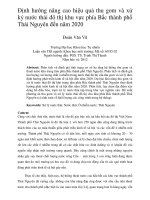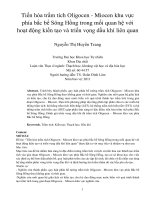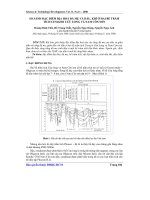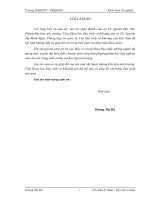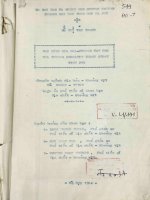Đặc điểm địa hóa và thạch học hữu cơ của than và sét than trong trầm tích miocen khu vực phía bắc bể sông hồng
Bạn đang xem bản rút gọn của tài liệu. Xem và tải ngay bản đầy đủ của tài liệu tại đây (555.01 KB, 20 trang )
ĐẠI HỌC QUỐC GIA HÀ NỘI
TRƯỜNG ĐẠI HỌC KHOA HỌC TỰ NHIÊN
------------***------------
LÊ HOÀI NGA
ĐẶC ĐIỂM ĐỊA HÓA VÀ THẠCH HỌC HỮU CƠ CỦA
THAN VÀ SÉT THAN TRONG TRẦM TÍCH MIOCEN
KHU VỰC PHÍA BẮC BỂ SÔNG HỒNG
LUẬN ÁN TIẾN SĨ ĐỊA CHẤT
HÀ NỘI - 2015
ĐẠI HỌC QUỐC GIA HÀ NỘI
TRƯỜNG ĐẠI HỌC KHOA HỌC TỰ NHIÊN
------------***------------
LÊ HOÀI NGA
ĐẶC ĐIỂM ĐỊA HÓA VÀ THẠCH HỌC HỮU CƠ CỦA
THAN VÀ SÉT THAN TRONG TRẦM TÍCH MIOCEN
KHU VỰC PHÍA BẮC BỂ SÔNG HỒNG
Chuyên ngành:
Khoáng vật học và Địa hóa học
Mã số:
62 44 02 05
LUẬN ÁN TIẾN SĨ ĐỊA CHẤT
Người hướng dẫn khoa học:
GS.TS. TRẦN NGHI
TS. TRẦN ĐĂNG HÙNG
Xác nhận NCS đã chỉnh sửa theo Quyết nghị của Hội đồng đánh giá luận án
Người hướng dẫn khoa học
Chủ tịch hội đồng đánh giá
Luận án Tiến sĩ
GS.TS. Trần Nghi
PGS.TS. Nguyễn Văn Vượng
HÀ NỘI - 2015
LỜI CAM ĐOAN
Tôi xin cam đoan đây là công trình nghiên cứu của tôi với sự hướng dẫn
khoa học của tập thể cán bộ hướng dẫn.
Các kết quả nêu trong luận án là trung thực và chưa từng được công bố
trong bất kỳ công trình nào khác.
Nghiên cứu sinh
Lê Hoài Nga
LỜI CẢM ƠN
Luận án được thực hiện tại Khoa Địa chất, Trường Đại học Khoa học
Tự nhiên, Đại học Quốc gia Hà Nội dưới sự hướng dẫn khoa học của Giáo sư,
Tiến sĩ, Nhà giáo Nhân dân Trần Nghi - Trường Đại học Khoa học Tự nhiên
và Tiến sĩ Trần Đăng Hùng - Tổng Công ty Thăm dò Khai thác. Với lòng kính
trọng và biết ơn, nghiên cứu sinh xin gửi lời cảm ơn chân thành tới sự hướng
dẫn tận tình của các thầy hướng dẫn.
Nghiên cứu sinh xin chân thành cảm ơn sự giúp đỡ, tạo điều kiện và
động viên của tập thể lãnh đạo Viện Dầu khí Việt Nam, Trung tâm Nghiên
cứu Tìm kiếm Thăm dò và Khai thác dầu khí, các cán bộ phòng Địa hóa và
đặc biệt cảm ơn sự hỗ trợ nhiệt tình của Ban chủ nhiệm dự án ENRECA, các
cán bộ chuyên gia trong dự án thuộc Cục Địa chất Đan Mạch và Greenland.
Xin chân thành cảm ơn tập thể lãnh đạo - cán bộ Khoa Địa chất, các cán
bộ phòng ban của Trường Đại học Khoa học Tự nhiên đã tạo điều kiện, giúp
đỡ nghiên cứu sinh trong suốt quá trình học tập tại trường.
Xin gửi lời tri ân sâu sắc đến sự ủng hộ, động viên tinh thần lớn lao của
gia đình, bạn bè đã dành cho nghiên cứu sinh trong suốt quá trình học tập, làm
việc và hoàn thành luận án này.
MỤC LỤC
DANH MỤC BẢNG .............................................................................................. 4
DANH MỤC HÌNH VẼ ......................................................................................... 5
CHƢƠNG 1. ĐỊA CHẤT KHU VỰC NGHIÊN CỨU ....................................... 19
1.1. VỊ TRÍ VÙNG NGHIÊN CỨU ................................................................. 19
1.2. ĐẶC ĐIỂM ĐỊA TẦNG TRẦM TÍCH..................................................... 21
1.3. LỊCH SỬ PHÁT TRIỂN ĐỊA CHẤT........................................................ 32
CHƢƠNG 2. CƠ SỞ LÝ THUYẾT VÀ PHƢƠNG PHÁP NGHIÊN CỨU ...... 35
2.1. CƠ SỞ LÝ THUYẾT ................................................................................ 35
2.1.1. Môi trƣờng thành tạo than bùn ............................................................ 37
2.1.2. Quá trình biến đổi của VCHC trong trầm tích – quá trình than hóa ... 42
2.1.3. Thành phần vật chất hữu cơ trong than – loại kerogen ....................... 45
2.2. TỔNG QUAN TÌNH HÌNH NGHIÊN CỨU THẠCH HỌC THAN
TRÊN THẾ GIỚI VÀ Ở VIỆT NAM............................................................... 53
2.2.1. Lịch sử nghiên cứu thạch học than trên thế giới ................................. 53
2.2.2. Lịch sử nghiên cứu thạch học than ở Việt Nam. ................................. 54
2.3. PHƢƠNG PHÁP NGHIÊN CỨU ............................................................. 61
2.3.1. Phƣơng pháp phân tích thạch học hữu cơ............................................ 61
2.3.2. Phƣơng pháp phân tích độ phản xạ vitrinit.......................................... 62
2.3.3. Phƣơng pháp nhiệt phân tiêu chuẩn Rock-Eval .................................. 63
2.3.4. Phƣơng pháp sắc ký ............................................................................. 68
CHƢƠNG 3. ĐẶC ĐIỂM THẠCH HỌC HỮU CƠ CỦA THAN VÀ
SÉT THAN KHU VỰC NGHIÊN CỨU ............................................................. 71
3.1. THÀNH PHẦN MACERAL TRONG THAN VÀ SÉT THAN ............... 71
3.1.1. Thành phần maceral trong than, sét than phụ thống Miocen dƣới ...... 71
3.1.2. Thành phần maceral trong than, sét than phụ thống Miocen giữa ...... 86
3.1.3. Thành phần maceral trong than phụ thống Miocen trên ..................... 92
3.2. NHÃN THAN (COAL RANK) ................................................................. 94
3.3. ĐIỀU KIỆN CỔ MÔI TRƢỜNG THÀNH TẠO THAN.......................... 96
1
CHƢƠNG 4. ĐẶC ĐIỂM ĐỊA HÓA VÀ KHẢ NĂNG SINH DẦU - KHÍ
CỦA ĐÁ MẸ THAN VÀ SÉT THAN KHU VỰC NGHIÊN CỨU ................. 100
4.1. ĐẶC ĐIỂM ĐỊA HÓA ............................................................................ 100
4.2. ĐẶC ĐIỂM CỦA CHẤT CHIẾT TRONG THAN VÀ MỐI QUAN HỆ
VỚI CÁC SẢN PHẨM DẦU -KHÍ TRONG KHU VỰC ............................. 110
4.3. ĐÁNH GIÁ TIỀM NĂNG SINH HYDROCACBON CỦA THAN VÀ
SÉT THAN KHU VỰC NGHIÊN CỨU ........................................................ 117
KẾT LUẬN ........................................................................................................ 121
KIẾN NGHỊ ....................................................................................................... 122
DANH MỤC CÔNG TRÌNH KHOA HỌC CỦA TÁC GIẢ LIÊN QUAN
ĐẾN LUẬN ÁN ................................................................................................. 123
TÀI LIỆU THAM KHẢO .................................................................................. 124
PHỤ LỤC ........................................................................................................... 134
BẢN ẢNH .......................................................................................................... 140
2
DANH MỤC CÁC KÝ HIỆU, CÁC CHỮ VIẾT TẮT
GK:
Giếng khoan
GC:
Sắc ký khí
GCMS:
Khối phổ ký
HC:
Hydrocacbon hay dầu, khí
HI:
Chỉ số hydrogen
LC:
Sắc ký lỏng
MVHN:
Miền võng Hà Nội
Pr:
Pristan
Ph:
Phytan
RE:
Rock Eval
Ro,%:
Độ phản xạ ánh sáng trong môi trƣờng dầu nhúng của vitrinit
S1:
Hydrocacbon tự do trong phép phân tích Rock Eval
S2:
Hydrocacbon đƣợc sinh ra trong phép phân tích Rock Eval
TOC,%:
Tổng hàm lƣợng cacbon hữu cơ tính bằng phần trăm trong đá
Tmax:
Nhiệt độ cực đại tại đỉnh pick S2 trong phép phân tích Rock Eval
VCHC:
Vật chất hữu cơ
3
DANH MỤC BẢNG
Bảng 2. 1. Phân loại kerogen theo nguồn gốc và dạng maceral ..................... 52
Bảng 2. 2. Các hệ thống phân loại maceral thông dụng hiện nay................... 56
Bảng 2. 3. Hệ thống phân loại maceral đƣợc sử dụng trong luận án .............. 57
Bảng 2. 4. Phân loại đá mẹ theo chỉ tiêu phân tích nhiệt phân RE ................. 66
Bảng 2. 5. Tổng hợp các chỉ tiêu phân loại kerogen [55] có chỉnh sửa.......... 67
Bảng 2. 6. Ngƣỡng trƣởng thành của đá mẹ theo Ro và Tmax ...................... 67
Bảng 2. 7. Phân loại đá mẹ theo hàm lƣợng bitum [52] ................................. 68
Bảng 3. 1. Thành phần maceral trong than, sét than và sét Miocen dƣới GK
102-CQ-1X ...................................................................................................... 72
Bảng 3. 2. Thành phần maceral trong mẫu than Miocen giữa ........................ 87
Bảng 3. 3. Thành phần maceral trong mẫu than Miocen trên GK 01-KT-TB08 lô MVHN-01KT khu vực MVHN ............................................................. 93
Bảng 4. 1. Kết quả phân tích RE mẫu sét, sét than và than khu vực
nghiên cứu .................................................................................................... 101
Bảng 4. 2. Độ sâu đạt ngƣỡng trƣởng thành của đá mẹ tại giếng khoan ...... 110
Bảng 4. 3. Thứ tự sinh dầu từ các maceral [90] ............................................ 119
4
DANH MỤC HÌNH VẼ
Hình 1. 1. Phân vùng cấu trúc bể trầm tích Sông Hồng và khu vực nghiên cứu ... 20
Hình 1. 2. Cột địa tầng tổng hợp khu vực phía Bắc bể Sông Hồng [4] .......... 25
Hình 1. 3. Mặt cắt mô tả các yếu tố cấu trúc khu vực nghiên cứu [4] ............ 34
Hình 2. 1. Mô hình mối tƣơng quan giữa độ ẩm, xu thế hydrocarbon với
nhãn than, trạng thái than hóa và độ phản xạ vitrinit (Flores, 2014 chỉnh sửa
theo Levin,1993) [24]...................................................................................... 43
Hình 2. 2. Vị trí GK Enreca-3 và vị trí các điểm lấy mẫu thực địa tại khu vực
đới nghịch đảo Oligocen Bạch Long Vĩ [59] .................................................. 60
Hình 2. 3. Biểu đồ tần xuất phân bố hàm lƣợng maceral trong mẫu sét GK
Enreca-3 trên đảo Bạch Long Vĩ..................................................................... 60
Hình 2. 4. Sơ đồ chu trình nhiệt phân [52, 85]. .............................................. 64
Hình 2. 5. Sơ đồ hệ thống sắc ký khí [47]....................................................... 69
Hình 3. 1. Cột địa tầng GK 102-CQ-1X ......................................................... 71
Hình 3. 2. Funginit (Fg) và sporinit (Sp) phân bố trên nền Densinit (D) trong
mẫu than 102-CQ-1X độ sâu 2080-2090m (ánh sáng trắng phản xạ, x50
trong dầu nhúng). ............................................................................................ 73
Hình 3. 3. Corpohuminit (Co) phân bố cộng sinh với suberinit (Su) trong
mẫu than 102-CQ-1X độ sâu 2080-2090m -(ánh sáng trắng phản xạ, x50
trong dầu nhúng). ............................................................................................ 73
Hình 3. 4. Corpohuminit (Co) phân bố cộng sinh với suberinit (Su) trên nền
khoáng vật trong mẫu sét than 102-CQ-1X độ sâu 2150-2160m (ánh sáng
trắng phản xạ, x50 trong dầu nhúng) .............................................................. 74
5
Hình 3. 5. Funginit (Fu) và Sporinit (Sp) phân bố trên nền Collodetrinit (Cd)
trong mẫu than Miocen dƣới GK 102-CQ-1X độ sâu 2660-2670m (ánh sáng
trắng phản xạ, x50 trong dầu nhúng) .............................................................. 74
Hình 3. 6. Collotelinit (Ct) trong mẫu than Miocen dƣới tại GK 102-CQ-1X
độ sâu 2590-2600m (ánh sáng trắng phản xạ, x50 trong dầu nhúng) ............. 75
Hình 3. 7. Collotelinit (Ct) trong mẫu than Miocen dƣới GK 102-CQ-1X độ
sâu 2660-2670 (ánh sáng trắng phản xạ, x50 trong dầu nhúng) ..................... 75
Hình 3. 8. Corpogelinit (Cg) phân bố chặt xít trong mẫu than Miocen dƣới
GK 102-CQ-1X độ sâu 2580-2590m (ánh sáng trắng phản xạ, x50 trong
dầu nhúng) ....................................................................................................... 75
Hình 3. 9. Telinit (T) thể hiện rõ cấu trúc mô gỗ của thực vật trong mẫu than
Miocen dƣới GK 102-CQ-1X độ sâu 3000-3010m (ánh sáng trắng phản xạ,
x50 trong dầu nhúng) ...................................................................................... 75
Hình 3. 10. Resinit (Re) và Vitrinit phân bố trên nền khoáng vật trong mẫu sét
than 102-CQ-1X độ sâu 2150-2160m (ảnh chụp dƣới ánh sáng phản xạ trắng
–bên trái- và ánh sáng huỳnh quang- bên phải; x50 trong dầu nhúng)........... 77
Hình 3. 11. Alginit trên nền vật chất hữu cơ vô định hình có khả năng phát
quang trong mẫu sét GK 102-CQ-1X độ sâu 2240-2250m (ánh sáng trắng và
ánh sáng huỳnh quang phản xạ, x50 trong dầu nhúng)................................... 77
Hình 3. 12. Sporinit (Sp) phân bố trên nền vitrinit trong mẫu than GK 102CQ-1X độ sâu 2080-2090m (ánh sáng huỳnh quang phản xạ, x50 trong
dầu nhúng) ....................................................................................................... 79
Hình 3. 13. Resinit (Re) phân bố cộng sinh với vitrinit mẫu than GK 102-CQ1X độ sâu 2080-2090m (ánh sáng trắng phản xạ - bên trái- và ánh sáng
huỳnh quang- bên phải, x50 trong dầu nhúng) ............................................... 79
6
TÀI LIỆU THAM KHẢO
TIẾNG VIỆT
1. Đỗ Bạt và nnk (2001), Định danh địa tầng và liên kết địa tầng trầm tích Đệ
Tam thềm lục địa Việt Nam, Báo cáo tổng kết nhiệm vụ nghiên cứu khoa
học cấp ngành, Viện Dầu khí Việt Nam, Hà Nội
2. Hoàng Thanh Cảnh và nnk (1975), Nghiên cứu một số vấn đề về trầm tích
chứa than dải Khoái Châu- Tiền Hải và triển vọng của nó, Tổng cục Địa
chất, Đoàn Địa chất 45, Hà Nội.
3. Lê Văn Cự, Hoàng Ngọc Đang, Trần Văn Trị và nnk (2007), Cơ chế hình
thành và các kiểu bể trầm tích Kainozoi Việt Nam, trong Địa chất và tài
nguyên dầu khí Việt Nam, Nhà Xuất bản Khoa học Kỹ thuật, Hà Nội.
4. Nguyễn Thị Dậu, Vũ Trụ và nnk (2013), Nghiên cứu tổng thể đánh giá
tiềm năng dầu khí toàn thềm lục địa Việt Nam - Đánh giá tiềm năng dầu
khí bể trầm tích Sông Hồng, Viện Dầu khí Việt Nam, Hà Nội.
5. Nguyễn Hiệp, Nguyễn Văn Đắc và nnk (2007), Địa chất và tài nguyên dầu
khí Việt Nam, Nhà Xuất bản Khoa học Kỹ thuật, Hà Nội, 549 trang.
6. Trịch Ích (1977), Đặc điểm thạch học và biến chất than Neogen vùng trũng
Hà Nội – dải Khoái Châu-Tiền Hải, Luận án Phó tiến sĩ, Đại học Mỏ Địa
chất, Hà Nội
7. Trần Nghi (Chủ trì) (2010), Báo cáo tổng kết đề tài cấp nhà nước Nghiên
cứu địa tầng phân tập (Sequence stratigraphy) các bể trầm tích sông Hồng,
Cửu Long, Nam Côn Sơn nhằm đánh giá tiềm năng khoáng sản, mã số:
KC.09.20/06-10, Trƣờng Đại học Khoa học Tự nhiên, Hà Nội
8. Hoàng Văn Thắng, Lê Diên Dực (2006), Hệ thống phân loại đất ngập nước
Việt Nam, Cục Bảo vệ môi trƣờng - Chƣơng trình bảo tồn đa dạng sinh học
vùng đất ngập nƣớc sông Mê Kong, Đại học Quốc gia Hà Nội, Hà Nội.
124
9. Nguyễn Thanh Tùng, Lê Hoài Nga và nnk (2013), Hệ thống dầu khí và mô
hình bể lô MVHN-01, Báo cáo hợp đồng nghiên cứu khoa học, Viện Dầu
khí Việt Nam, Hà Nội.
10.Vũ Trụ, Lê Hoài Nga và nnk (2010), Đánh giá tiềm năng và khả năng khai
thác khí than CBM tại dải nâng trung tâm MVHN (Phù Cừ - Tiên Hưng –
Kiến Xương – Tiền Hải), Báo cáo tổng kết nhiệm vụ nghiên cứu khoa học
cấp ngành, Viện Dầu khí Việt Nam, Hà Nội.
TIẾNG ANH
11.ASTM (1992), Classification of Coal by Rank, in ASTM D 388-92a,
American Society for Testing and Materials, Philadelphia, PA, USA.
12.ASTM (2005), Standard Test Method for Microscopical Determination of
the Vitrinit Reflectance of Coal in D2798-09a, American Society for
Testing and Materials, Philadelphia, USA.
13.ASTM (2005), Standard Test Method for Microscopical Determination of
the Maceral Composition of Coal, in D2799-05a, American Society for
Testing and Materials, Philadelphia, USA.
14.Bray E.E. and Evans E.D. (1961), ―Distribution of n-paraffins as a clue to
recognition of source beds‖. Geochim. Cosmochim Acta, 22(1), pp. 2-15.
15.Brooks J.D., Gould K., and Smith J.W. (1969), ―Isoprenoid hydrocarbons in
coal and petroleum‖. Nature, 222(1), pp. 257- 259.
16.Calder J.H. (1993), ―The evolution of a ground-water-influenced
(Westphalian B) peat-forming ecosystem in a piedmont setting: The No.3
seam,Springhill coalifield, Cumberland Basin, Nova Scotia, In: Cobb, J.C.
& Cecil, C.B. (Eds.), Modern and ancient coal- forimng environment‖,
Geology Society of America special paper, 286(1), pp. 153-180.
125
17.Calder J.H., Gibling M.R., and Mukhopadhyay P.K. (1991), ―Peat
formation in a Westphalian B piedmont setting, Cumberland Basin, Nova
Scotia: Implications for the maceral based interpretaion of rheotrophic and
raised paleomires‖. Bulletin de la Societé Géologique de France, 163(1),
pp. 283-293.
18.Castano J.R. and Sparks D.M. (1974), ―Interpretation of vitrinit reflectance
measurements in sedimentary rocks, and determination of burial history
using vitrinit reflectance and authigenic minerals‖. Geology Society, 153(1),
pp. 31-53.
19.Diessel C.F.K. (1986), On the Correlation between Coal Facies and
Depositional Environments in Advances in the Study of the Sydney Basin,
University of Newcastle, Australia.
20.Diessel C.F.K. (1992), Coal-bearing Depositional Systems, SpringerVerlag, Heidenberg -Berlin.
21.Durand B. (1980), Kerogen: Insoluble organic matter from sedimentary
rocks, Technip edition, France.
22.Espitalié J., et al. (1977), Methode rapide de caracterisation des roches
meres, de leur potential petrolieret de leur degre d'evolution, Technip
edition, France.
23.Flores R.M. (2014), ―Chapter 3 - Origin of Coal as Gas Source and
Reservoir Rocks‖, in Coal and Coalbed Gas, 1(3), pp. 97-165.
24.Flores R.M. (2014), ―Chapter 4 - Coalification, Gasification, and Gas
Storage‖, in Coal and Coalbed Gas, Elsevier, 1(4), pp. 167-233.
25.Flores R.M. (2014), Coal and Coalbed Gas: Fueling the Future, ed. 1st.,
Elsevier, America.
126
26.Frank M.C. (1999), Organic petrology and depositional environments of the
Souris Lignit, Ravenscrag Formation (Paleocen), southern Saskatchewan,
Canada, Department of Geology, University of Regina, Springer-Verlag,
Canada.
27.Geochem (1994), Geochemical Evaluation of the 102-CQ-1X, Red River
basin, Block 102, Offshore VietNam, Idemitsu Hai Phong Exploration Co.,
VietNam.
28.Geochem (1995), A Geochemical Evaluation of the 102-HD-1X well, Red
River Basin, Block 102, offshore VietNam, Idemisu Hai Phong, Hai Phong.
29.Horsfield, B., Yordy K., and Crelling J. (1988), ―Determining the
petroleum-generating potential of coal using organic geochemistry and
organic petrology‖, Organic Geochemistry, 13(1-3), pp. 121-129.
30.Huang W.Y., Meinschein W.G. (1979), ―Sterols as ecological indicators‖,
Geochim. Cosmochim, 43(1), pp. 79-745.
31.Hunt J.M. (1980), Petroleum Geochemistry and Geology, ed. 2nd., W. H.
Freeman and Company, New York.
32.Hunt J.W. (1988), ―Sedimentation rates and coal formation in the Permian
basins of eastern Australia‖, Australian Journal of Earth Sciences: An
International Geoscience Journal of the Geological Society of Australia,
35(2), pp. 259-274.
33.Indiana Geological Survey,
Indiana Coal: Macerals. Available from:
/>34.ICCP (1963), International hand-book of coal petrography, CNRS, Paris.
35.ICCP (1971), International handbook of coal petrography, CNRS, Paris.
36.ICCP (1975), International hand-book of coal petrography, CNRS, Paris.
37.ICCP (1993), International hand-book of coal petrography, University of
Newcastle on Tyne, England.
127
38.ICCP (1998), ―The new vitrinit classification (ICCP System 1994)‖, Fuel,
77(5), pp. 349-358.
39.ICCP (2001), ―The new inertinit classification (ICCP System 1994)‖, Fuel,
80(4), pp. 459-471.
40.ISO7404- 2 (1985), Methods for the petrographic analysis of bituminous
coal and anthracite—part 2: methods for preparing coal samples, in ISO
7404-2, Geneva, Switzerland.
41.ISO7404-3 (1994a), Methods for the petrographic analysis of bituminous
coal and anthracite—part 3: methods maceral group, in ISO 7404-2,
Geneva, Switzerland.
42.Katz B. (1980), Petroleum source rocks, Springer-Verlag, USA.
43.Kwiecińska B. and Petersen H.I. (2004), ―Graphite, semi-graphite, natural
coke, and natural char classification—ICCP system‖, International Journal
of Coal Geology, 57(2), pp. 99-116.
44.Lijimbach G.W.M. (1975) ―On the origin of petroleum‖, in 9th World
Petroleum Congress - Applied Science London, 10(1), p. 357-369.
45.GraciaValles., Prado. J., and Vendrell Sar M. (1994), ―Maceral distribution
in Garumnian coals and paleoenvironmental implications in the central
Pyrenees, Spain‖, Internation Journal of Coals Geology, 25(1), pp. 27-46.
46.Mac Gregor D.S., Mackenzie A.S. (1987), ―Quantification of oil generation
and migration in the Malacca Strait region central Sumatra‖, in Proceedings
Indonesian Petroleum Association 15th Annual Convention - Jakarta, 1(1),
pp. 305-320.
47.McCarthy K. (2011), ―Basic Petroleum Geochemistry for Source Rock
Evaluation‖, Oilfield Review Summer 2011, 23(2), pp. 12.
128
48.Mello M.R., et al. (1988), ―Geochemical and biological marker assessment
of depositional environments using Brazilian offshore oils‖, Marine and
Petroleum Geology, 5(1), pp. 205-223.
49.Moore P.D. (1989), ―Ecological and hydrological aspect of peat forming
process- a review‖,
in Peat and coal: Origin, facies, and depositional
models, Internation Journal of Coals Geology, 12(1), pp. 89-104.
50.Murray A.P., et al. (1997) ―Oleanans in oils and sediments: Evidence of
marine influence during early diagenesis?‖, Geochimica et Cosmochimica
Acta – Elsevier, 61(1), pp. 1261-1276.
51.Nielsen L.H., et al. (1999), ―Modelling of hydrocarbon generation in the
Cenozoic Song Hong Basin, Vietnam: a highly prospective basin‖, Journal
of Asian Earth Sciences, 17(1–2), p. 269-294.
52.Ower J. (1990), Element of Geochemistry, ed. Robertson, Gwynedd, U.K.
53.Pepper A.S., Corvi P.J. (1995) ―Simple kinetic models of petroleum
formation. Part I: oil and gas generation from kerogen‖, Marine and
Petroleum Geology, 12(3), pp. 291-319.
54.Peters K.E. (1986), ―Guidelines for evaluating petroleum source rock using
programmed analysis‖, The American Association of Petroleum Geologists
Bulletin, 70 (1), pp. 318–329.
55.Peters K.E. and Cassa M.R. (1994), Applied source rock geochemistry - The
Petroleum System- From Source to Trap, editors: L.B. Magoon, Dow,W.G.,
American Association of Petroleum Geologists, USA.
56.Peters K.E. et al. (2000), ―A New Geochemical-Sequence Stratigraphic
Model for the Mahakam Delta and Makassar Slope, Kalimantan,
Indonesia‖, AAPG Bulletin, 84(1), pp.12-24.
129
57.Peters, K.E. and Moldowan J.M. (1993), The Biomarkers guide:
Interpreting molecular fossils in petroleum and ancient sediments,
Cambridge University Press, England.
58.Peters, K.E., Walters C.C., and Moldowan J.M. (2005), The biomarker
guide Vol. 2, Cambridge University Press, England.
59.Petersen H.I. (2013), ―Source rock quality of the ENRECA-3 well: 500 m
of highly oil-prone mudstones (presentation)‖ in 35th Anniversary of VPI’s
Establishment, Science & Technology Conference 22nd -23rd May 2013,
Viet Nam Petroleum Institute, Hanoi, Vietnam.
60.Petersen H.I. et al. (2001), ―Petroleum potential of Oligocen lacustrine
mudstones and coals at Dong Ho, Vietnam — an outcrop analogue to
terrestrial source rocks in the greater Song Hong Basin‖, Journal of Asian
Earth Sciences, 19(1–2), pp. 135-154.
61.Petersen H.I. et al. (2003), ―Coal generation oil: source rock evaluation and
petroleum geochemistry of the Lulita oilfield, Danish North Sea‖, Journal
of Petroleum Geology, 23(1), pp. 55-90.
62.Petersen H.I., J. Andsbjerg (1996), ―Organic facies development within
Middle Jurassic coal seams, Danish Central Graben, and evidence for
relative sea-level control on peat accumulation in a coastal plain
environment‖, Sedimentary Geology, 106(3), pp. 259-277.
63.Petersen H.I., Nytoft H.P., and Nielsen L.H. (2004), ―Characterisation of oil
and potential source rocks in the northeastern Song Hong Basin, Vietnam:
indications of a lacustrine-coal sourced petroleum system‖, Organic
Geochemistry, 35(4), pp. 493-515.
64.Petersen H.I., Rosenberg P.(1998), ―Reflectance retardation (supppresion)
and source rock properties related to hydrogen-enriched vitrinit in middle
Jurassic coals, Danish North Sea‖, Journal of Petroleum Geology, 21(3),
pp. 247-263.
130
65.Peterson H.I., et al. (1998), Organic Petrography and Geochemistry of
three samples from DongHo, Vietnam, EPF-97 project: Description of the
Petroleum system(s) of the Song Hong Basin, GEUS, Danmark.
66.Peterson H.I., et al. (2005), ―Source-rock properties of lacustrine mudstone
and coals (Oligocen DongHo Formation) onshore Song Hong Basin,
Northern Vietnam‖, International Journal of Coals Geology, 28(1), pp. 1933.
67.Petronas (2007), 102-TB-1X Final well report, Petronas, VietNam.
68.Potter J. (1998), A petrographic Atlas of Coal Macerals and Dispersed
Organic Matter, Canmet Energy Technology Centre: Canadian Society for
Coal Science and Organic Petrology, Geological Survery of Canada ,
Calgary- Canada.
69.Powell, T.G. and McKirdy D.M. (1973), ―Relationship between ratio of
pristan to phytan, crude oil composition and geological environment in
Australia‖, Natural Physical Science, 243(1), p. 37-39.
70.Schopf J.M. (1956), ―A definition of coal‖, Economic Geology, 51(1), pp.
521-527.
71.Seifert W.K., Moldowan J.M. (1987), ―Applications of sterans, terpans, and
monoaromatics to the maturat ion, migrationand source oils‖, Geochimica
et Cosmochimica Acta, 42(1), pp. 77-92.
72.Senftle J.T. and Charles R.L. (1991), ―Vitrinit Reflectance as a Tool to
Assess Thermal Maturity, Chapter 12: Geochemical methods and
exploration‖, AAPG Special Volume, 1(1), pp. 39-77.
73.Stach E. (1935), Textbook of Coal Petrology, Gerbuder Borntraeger Printer,
Berlin- Gemany.
74.Stach E. (1982), Stach's Textbook of Coal Petrology, ed. 1st. edition,
Gerbuder Borntraeger Printer, Berlin- Gemany.
131
75.Stopes M.C. (1919), ―On the four visible ingredients - Banded Bituminous
Coal: Studies in the Composition of Coal‖, in Proceedings of the Royal
Society, 1(B90), pp. 470-487.
76.Stopes, M.C. (1935), ―On the petrology of banded bituminous coals‖, Fuel,
14(1), pp. 4-13.
77.Suárez-Ruiz I. and Crelling C.J. (2008), Applied Coal Petrology - The role
of petrology in Coal Ultilization, Elsevier Ltd, USA.
78.Sýkorová I., et al. (2005), ―Classification of huminit—ICCP System 1994‖,
International Journal of Coal Geology, 62(1–2), pp. 85-106.
79.Taylor, G.H., et al. (1998), Organic Petrology – A new handbook
incorporating some revised parts of Stach’s Textbook of coal petrology,
Gebruder Borntraeger Printer, Berlin-Germany.
80.Teichmüller M. (1974), ―Generation of petroleum like substances in coal
seams as seen under the microscope‖, Advances in Organic Geochemistry,
1973(1), pp. 321 - 348.
81.Teichmüller M. (1986), ―Organic petrology of source rocks, history and
state of the art‖, Organic Geochemistry, 10(1–3), pp. 581-599.
82.Teichmüller M. (1989), ―The genesis of coal from the viewpoint of coal
petrology‖, International Journal of Coal Geology, 12(1–4), pp. 1-87.
83.Teichmüller M. and Teichmüller R. (1979), ―Chapter 5 Diagenesis of Coal
(Coalification)‖ in Developments in Sedimentology, L. Gunner and V.C.
George Editors, Elsevier, USA.
84.Teichmüller M., Durand B. (1983), ―Fluorescence microscopical rank
studies on liptinits and vitrinits in peat and coals, and comparison with
results of the rock-eval pyrolysis‖, International Journal of Coal Geology,
2(3), p. 197-230.
132
85.Tissot B.P. and Welte D.H. (1978), Petroleum formation and occurence,
New York, Springer-Verlag Press, USA.
86.Total (1990a), Vietnam-Gulf of TonKin sedimentological, petrographic,
stratigraphic and geochemical study of exploration well 103-TG-1X, Total,
Ha Noi.
87.Total (1990b), Vietnam-Gulf of TonKin sedimentological, petrographic,
stratigraphic and geochemical study of exploration well 103-TH-1X, Total,
Ha Noi.
88.Van Krevelen, D.W. (1950), ―Graphical-statistical method for the study of
structure and reaction processes of coal‖, Fuel, 29(1), pp. 269-284.
89.Waples D.W. (1985), Geochemistry in petroleum exploration, International
Human Resources Development Corporation, Boston.
90.Wilkins R.W.T. and S.C. George (2002), ―Coal as a source rock for oil: a
review‖, International Journal of Coal Geology, 50(1–4), pp. 317-361.
91.Xiao X., Lui D., Fu J., Jin K., (1993), ―Simulation of hydrocarbon
generation from single macerals‖, Organic Geochemistry, Poster Sessions
from the 16th International Meeting on Organic Geochemistry, pp. 153-156.
133
